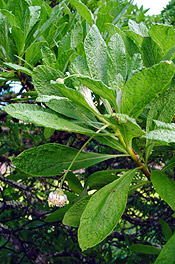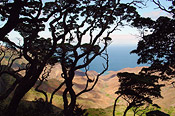Introduction
National tree of St Helena.
Commidendrum robustum grows to a height of five to eight metres. It has a highly branching structure that forks low and produces an umbrella-like canopy. White flower heads droop from the ends of branches.
Why is this species important?
C. robustum is one of fourteen globally threatened and endemic tree species occurring on St Helena. This species was designated as St Helena's national tree in 1977. To help act as a symbol of the island's conservation and community spirit, a native forest of C. robustum was planted to mark the Millennium. The endemic plants of St Helena are of great biogeographical significance and provide the habitat for equally rare and unusual animal species. The gumwoods are known to be hosts for many endemic invertebrates, particularly weevils.
Where is it found?
C. robustum is found only on the sub-tropical island of St Helena in the South Atlantic, located 1,960 km from the south-west coast of Africa and 2,900 km east of South America. The area of St Helena is just 122 km². C. robustum woodland once stretched across one-third of the island at an altitude of 300-600m. The only woodland now remaining is at Peak Dale where about 1,000 trees grow on an area of 3 ha of steep slopes. There are smaller, scattered populations at Deep Valley (21 trees), Marias (<5 trees), Rock Rose (7 trees), Longwood (3 mature trees, although young trees have now been established), and Thompson's Wood (1 tree). Most of these are found growing close to or out of cliffs.
How do people use it?
C. robustum has been an important source of timber since the island was settled by humans in 1659. The timber has been used for fuel and building. Although not used today, with its highly branched nature and dense hard, fine grain the wood has the potential to be of local value in the future if it can be managed sustainably, as a windbreak, as a source of pollen for honey production, and for high value products for the tourism industry. One local carpenter has already established a small experimental plantation to provide wood for craftwork in the future.
Why is it threatened?
C. robustum is threatened primarily by the impacts of human activities. Since settling the island, humans have used C. robustum for timber and firewood. Forests have also been cleared for pasture. The introduction of goats and other browsing livestock to the island led to severe overgrazing and prevented regeneration. It is likely that timber shortages became apparent so quickly because the browsing of goats had been killing young trees for 150 years, so that the more accessible parts of the forests were in a senile state when later settlers arrived. In 1991 the Peak Dale C. robustum was attacked by the jacaranda bug Orthezia insignis, a sucking insect that takes the sap from trees. This threatened to devastate the remaining population until a biological control agent, a ladybird Hyperaspis pantherina, was introduced from Kenya.
What conservation action is needed?
A programme of conservation for C. robustum forests has operated since the mid 1980s, although lack of continuity and limited local resources have limited progress. Efforts at Peak Dale have included fencing off the site to prevent damage from browsing sheep and cattle, controlling the growth of exotic weeds and planting young trees, often with the help of school groups and volunteers. A programme of replanting has been in operation at Horse Plain Point. The Millennium Gumwood Forest Project has resulted in the planting of over 4,000 trees in a previously barren and degraded wasteland. The area was originally part of the 600 ha Great Wood that was lost through deforestation in the 18th and 19th centuries. C. robustum has also been established behind High Peak, at Pounceys, along the golf course and in the grounds of many of the island's first and middle schools.Attention is also being focused on small and disjunct wild populations that have either been attacked by the jacaranda bug or heavily invaded by alien plant species such as flax Phormium tenax , black olive Olea africana and ink, Cestrum laevigatum. Weeds have been cleared at a number of sites and gumwoods replanted to restock affected populations. Seeds have been collected from different populations and seedlings are being grown in nurseries ready for planting back into different sites.The Global Trees Campaign is supporting the conservation of this species through the provision of a small grant; more information is available on the project pages here.
Selected references
Cronk, Q.C.B. (2000) The endemic flora of St Helena. Anthony Nelson Publishers, Oswestry, UK.
Newsletter of the Millennium Gumwood Forest Project, Volume 1, Issue 1, December 2000.
Local contacts
The Environmental Conservation Section
Agriculture and Forestry Department
Scotland
St. Helena
South Atlantic Ocean
Millennium Gumwood Forest Project Steering CommitteeEnvironment, Planning and Development Section
Development and Economic Planning Department
1 Main Street
Jamestown
St Helena
South Atlantic Ocean
STHL 1ZZ
Phone/Fax: +290 2105
e-mail: [email protected]
|
 |


|